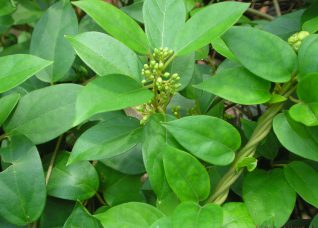
MinerAlert

MinerAlert
Gymnema sylvestre
Asclepiadaceae [Apocynaceae]
Gurmar, Australian cow plant, chigeng teng, buti, kober, mesasrngi, podapatri

The plant grows in India, Australia, Tropical Africa, and parts of Southeast Asia (Khare, 2016).
The whole plant, especially the root and leaves.
The herb can be taken as a tea, alone or in combination with other plants. Additionally, the plant is available commercially as extracts, pills, and capsules. The fresh or dried leaves are eaten for diabetes. A paste made from the leaves is applied to fractured bones. The juice obtained from the leaves is taken for diabetes, gastric problems, and malaria. Aqueous extracts obtained from the leaves are taken for diabetes and urinary problems. The roots and leaves are taken as a tea for stomachache. A tea made from the root is taken for snakebite. A powder made from the stem and roots is taken as a tonic (Khare, 2016, 2004; Tiwari et al., 2015; Quattrocchi, 2012; Dev, 2012).
Gymnema has long been used in Ayurveda for the treatment of various ailments including diabetes (known as Madumeha in Ayurvedic medicine), obesity, rheumatism, arthritis, skin problems, osteoporosis, inflammation of blood vessels, hemorrhoids, asthma, bronchitis, epilepsy, eye problems, microbial infections, and snakebites. Gymnema extracts or chewing the leaves can temporarily reduce the taste sensation for sweetness (Khare, 2016; Vohora and Vohora, 2016; Dev, 2012).
Gymnema shows potential for the treatment of diabetes since studies show beneficial effects on blood sugar control and reduction of cravings for sweets. Additionally, its active ingredients promote regeneration of pancreatic tissue. Gymnema extracts might reduce body weight, blood cholesterol, and triglyceride levels (Khare, 2016; Tiwari et al., 2014).
The plants main constituents include triterpenoid saponins, especially gymnemic acids A-D, which have blood glucose lowering effects as well as interfere with the taste sensation for sweets (Khare, 2016, 2007, 2004; Dev, 2012).
Kamble et al. (2015) evaluated the pharmacodynamics and pharmacokinetic interactions between a gymnema leaf extract and an oral hypoglycemic drug (glimepiride), in streptozotocin (STZ)- induced diabetic rats. The results showed that the concomitant oral administration of a gymnema extract and the anti-diabetic drug showed beneficial pharmacodynamic interactions. The authors stated that the concomitant administration of gymnema extract and glimepiride might theoretically be of benefit, especially in diabetic patients.
A systematic review of the literature regarding the use of gymnema for diabetes and obesity showed that gymnemic acid, one of the main active ingredients in the leaves, possessed anti-obesity and anti-diabetic properties, as well as decreased body weight and inhibited glucose absorption (Pothuraju et al., 2014).
Arun et al. (2014) mentioned that the aqueous extracts obtained from gymnema leaves possess antiulcer, anti-allergic, as well as anti stress effects, that could be due to a cell-protective mechanism exerted by the plant’s active ingredients.
Safety/Precautions:
Before you decide to take any medicinal herb or herbal supplement, be sure to consult with your health care professional first. Avoid self-diagnosis and self-medication: Always be on the safe side!